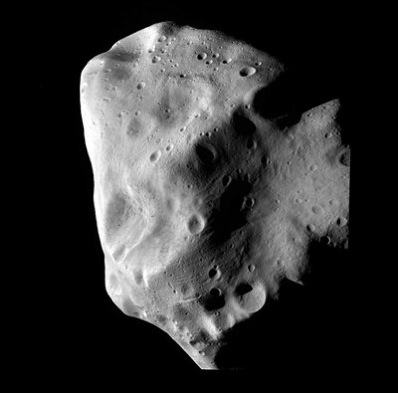
Cold asteroid with
a warm heart
DR EMILY BALDWIN
ASTRONOMY NOW
Posted: 27 October 2011


Asteroid 21 Lutetia may be hiding a once molten metal-rich core underneath its battered surface, say planetary scientists analysing data from the Rosetta spacecraft that swooped past the ancient asteroid last summer.
The European Space Agency's Rosetta probe is on its way to rendezvous with Comet 67P/Churyumov-Gerasimenko in 2014, but on 10 July 2010 it flew past asteroid 21 Lutetia, snapping shots of a cracked and dented surface as a result of eons worth of impacts. At the time, 132 x 100 x 76km Lutetia was the largest asteroid visited by a spacecraft; Vesta now holds that record with the Dawn spacecraft in orbit around it since July of this year.

Lutetia at closest approach during the Rosetta flyby. Analysis suggests that Lutetia could be hiding a dense core beneath its battered surface typical of all asteroids. Image: ESA 2010 MPS for OSIRIS Team MPS/UPD/LAM/IAA/RSSD/INTA/UPM/DASP/IDA.
Asteroids are jumbled blocks of rocks with void spaces in between the boulders. Because they are much smaller than planets they are thought to not be capable of maintaining an internal heat source, or even melt and form a dense core. But, in a series of three papers presented in the journals Science and Planetary Space Science, scientists propose that underneath Lutetia's extinct surface is a melted core that retained heat from the early planet-forming stage of Solar System history.
"Modeling suggests that Lutetia was partially differentiated for the first one million years only due to radio-nuclide heating, and then solidified," clarifies Rosetta team leader Holger Sierks of the Max-Planck Institute for Solar System Research. "The core is certainly not molten today."
The Rosetta team found Lutetia to boast a density higher than most meteorite samples recovered on Earth. Since huge fractures and craters are visible across the asteroid's surface, this high density cannot apply to the whole asteroid. Instead, the scientists propose the density is concentrated in a metal-rich core.
"We are inferring this possibility from its high bulk density," MIT's Benjamin Weiss tells Astronomy Now. "If Lutetia had an extremely low porosity or had a very unusual metal-rich initial composition, then we could explain its high density without a core. Ideally, we would have seen a crater excavating deep into the interior revealing a metallic centre, although such a situation is highly unlikely since such a body would not likely have survived such a major collision! So you just have to decide which is weirder: a hidden metallic core, very metal-rich composition, or very low porosity."

Ceres is thought to have differentiated into a rocky core and icy mantle. Image: NASA/ESA/STScI.
If a core does exist it will be the first asteroid confirmed to be partially differentiated, with a melted interior overlain by progressively cooler layers. Spherical Ceres, a dwarf planet and the largest asteroid at 950 kilometres across, is thought to be differentiated into a rocky core and icy mantle, and perhaps even an ocean, speculation that Dawn will confirm or refute when it arrives at its next target in February 2015.
"Lutetia is closer to Vesta, if Vesta turned out to be differentiated as expected," Sierks tells Astronomy Now. "If it is differentiated it will constrain the modeling efforts and potentially support the hypothesis that small asteroids could have seen sufficient heating that material could have been molten during accretion that led to metal enrichment of the higher density cores."
The findings may provide evidence for a theory developed last year by Weiss and MIT colleagues Linda Elkins-Tanton and Maria Zuber, who found samples of the Allende meteorite that were strongly magnetized. They proposed that such magnetization most likely occurred in an asteroid with a melted, metallic core, a big shift from the traditional picture of asteroids as unmelted objects towards an asteroid belt with hidden diversity.
"We think asteroids must grow to a radius of at least 20-30 kilometres in order to experience silicate melting and differentiate," says Weiss. "The fact that Lutetia has a high density for an asteroid makes it somewhat anomalous. This might at first glance seem to suggest that few other asteroids are partially differentiated. However, most asteroids are thought to be highly porous as a result of being subjected to billions of years of impacts, offsetting the high density of any metal-rich interior and making it difficult to see evidence for a metallic core from a bulk density measurement."
Weiss adds that since planets don’t retain a record of these early differentiation processes, Lutetia may be a relic of the first events of melting in a body, but the “smoking gun” could be provided by a sample taken directly from an asteroid.
|



